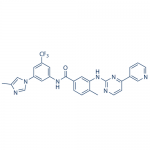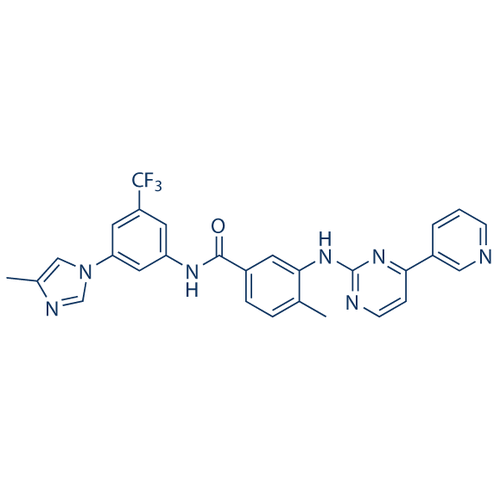| Product Name | Nilotinib |
| Description |
BCR-ABL kinase inhibitor |
| Purity | >99% |
| CAS No. | 641571-10-0 |
| Molecular Formula | C28H22F3N7O |
| Molecular Weight | 529.5 |
| Field of Use | Not for use in humans. Not for use in diagnostics or therapeutics. For in vitro research use only. |
Properties
| Storage Temperature | -20ºC |
| Shipping Temperature | Shipped Ambient |
| Product Type | Inhibitor |
| Solubility | Soluble in DMSO (50 mg/ml), chloroform, DMF (~3 mg/ml), water(very poorly soluble, maximum solubility in plain water is estimated to be about 10-20 µM; buffers, serum, or other additives may increase or decrease the aqueous solubility), and ethanol(very poorly soluble) |
| Source | Synthetic |
| Appearance | Crystalline powder |
| SMILES | C5=C([N]1C=C(N=C1)C)C=C(NC(=O)C2=CC(=C(C=C2)C)NC3=NC(=CC=N3)C4=CN=CC=C4)C=C5C(F)(F)F |
| InChI | InChI=1S/C28H22F3N7O/c1-17-5-6-19(10-25(17)37-27-33-9-7-24(36-27)20-4-3-8-32-14-20)26(39)35-22-11-21(28(29,30)31)12-23(13-22)38-15-18(2)34-16-38/h3-16H,1-2H3,(H,35,39)(H,33,36,37) |
| InChIKey | HHZIURLSWUIHRB-UHFFFAOYSA-N |
| Safety Phrases |
Classification: Not a hazardous substance or mixture. Safety Phrases: S22 - Do not breathe dust. S24/25 - Avoid contact with skin and eyes. S36/37/39 - Wear suitable protective clothing, gloves and eye/face protection. |
| Cite This Product | Nilotinib (StressMarq Biosciences Inc., Victoria BC CANADA, Catalog # SIH-463) |
Biological Description
| Alternative Names | 4-methyl-N-[3-(4-methylimidazol-1-yl)-5-(trifluoromethyl)phenyl]-3-[(4-pyridin-3-ylpyrimidin-2-yl)amino]benzamide |
| Research Areas | Apoptosis, Cancer, Cancer Growth Inhibitors, Cell Signaling, Tyrosine Kinase Inhibitors |
| PubChem ID | 644241 |
| Scientific Background | Nilotinib is a potent and selective inhibitor of Bcr-Abl tyrosine kinase, with additional activity against JAK2/STAT5 and MDM2 at the post-translational level. In neurodegenerative disease research, Nilotinib has gained attention for its ability to modulate autophagy and promote the clearance of misfolded proteins, such as alpha-synuclein and tau. These properties are particularly relevant in Parkinson’s and Alzheimer’s disease models, where impaired protein degradation contributes to neuronal dysfunction. Nilotinib’s neuroprotective effects are also linked to its capacity to influence dopaminergic signaling and reduce neuroinflammation, making it a promising candidate for repurposing in neurodegenerative therapeutics. |
| References |
1. Gallipoli P., et al. (2014) Blood. 2. Zhang H., Gu L., Liu T., Chiang K.Y., & Zhou M. (2014) PloS One. 9(6): e100960. |



Reviews
There are no reviews yet.